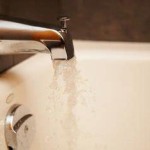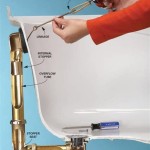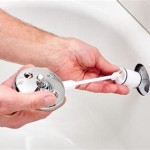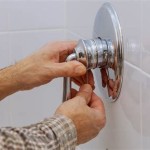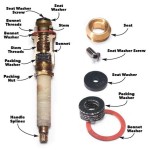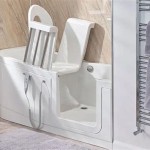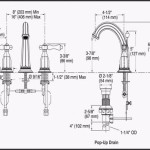How To Clean a Rusty Bathtub Drain
A rusty bathtub drain is an unsightly problem and can also potentially lead to further damage, such as clogs and leaks. Rust forms when iron or steel, common materials used in drain components, are exposed to water and oxygen over a period of time. Addressing rust issues promptly is crucial for maintaining the functionality and appearance of the bathtub. This article provides a comprehensive guide on how to clean a rusty bathtub drain, covering various methods, necessary tools, and preventative measures.
Before commencing any cleaning procedure, it is essential to assess the severity of the rust. Surface rust, characterized by a light orange or brown discoloration, is typically easier to remove. However, deeper, more extensive rust can indicate significant corrosion that might compromise the structural integrity of the drain components. In such instances, replacement of the affected parts may be the most effective long-term solution. Safety precautions should be observed throughout the cleaning process, including wearing gloves and eye protection to shield against potential irritants and sharp edges.
Assessing the Rust and Gathering Necessary Tools
The first step in cleaning a rusty bathtub drain involves a careful inspection to determine the extent of the rust. Examine the drain flange (the visible part of the drain inside the tub), the stopper mechanism, and any exposed piping to identify all affected areas. Use a flashlight to get a better view of hard-to-reach spots. Pay attention to whether the rust is merely superficial or has caused pitting and erosion of the metal. Significant pitting suggests that the rust has penetrated deep into the material and may require more aggressive cleaning methods or, as previously mentioned, replacement of the affected part.
Once the assessment is complete, gather the necessary tools and materials. A basic cleaning toolkit should include:
- Rubber gloves: To protect hands from harsh chemicals and sharp edges.
- Eye protection: To safeguard eyes from splashes and debris.
- Old toothbrush or scrub brush: For scrubbing away loose rust and debris.
- Microfiber cloths or sponges: For wiping surfaces clean.
- White vinegar: A mild acid that can dissolve rust.
- Baking soda: An abrasive cleaner that helps remove rust and grime.
- Lemon juice: Another mild acid that can help dissolve rust.
- Rust remover product (optional): For more stubborn rust stains. Choose a product specifically designed for bathroom fixtures.
- Steel wool or scrub pad (optional): For aggressive scrubbing, but use with caution to avoid scratching.
- Small container or bowl: For mixing cleaning solutions.
- Pliers or screwdriver (optional): For removing the drain stopper or other drain components, if necessary.
Having these tools and materials readily available will streamline the cleaning process and ensure that the job can be completed efficiently.
Cleaning Methods for a Rusty Bathtub Drain
Several methods can be employed to clean a rusty bathtub drain, ranging from gentle to more aggressive approaches. The choice of method will depend on the severity of the rust and the type of material the drain is made of. Always test any cleaning solution on a small, inconspicuous area first to ensure it does not damage the finish.
Method 1: Vinegar and Baking Soda
This method is effective for removing light to moderate rust and is relatively gentle on most drain materials. Begin by pouring approximately one cup of baking soda down the drain. Follow this with one cup of white vinegar. The combination will create a fizzing reaction that helps to loosen rust and grime. Allow the mixture to sit for at least 30 minutes, or even longer for more stubborn rust. After the soaking period, pour hot water down the drain to flush away the dissolved rust and residue. Use an old toothbrush or scrub brush to scrub the drain flange and any visible rusted areas. Rinse thoroughly with clean water.
Method 2: Lemon Juice and Salt
Lemon juice, like vinegar, contains citric acid, which can help dissolve rust. Cut a lemon in half and sprinkle salt generously onto the cut side. Use the lemon to scrub the rusted areas of the drain. The salt acts as a mild abrasive to help remove the rust particles. Reapply salt as needed. After scrubbing for several minutes, rinse the drain thoroughly with water. This method is particularly effective for removing surface rust and is safe for use on most drain materials.
Method 3: Commercial Rust Remover
For more stubborn rust stains, a commercial rust remover may be necessary. Always choose a product specifically designed for bathroom fixtures and follow the manufacturer's instructions carefully. Wear gloves and eye protection when using rust removers, as they can be corrosive. Apply the rust remover to the affected areas and allow it to sit for the recommended time. Then, scrub the drain with a brush or sponge and rinse thoroughly with water. Ensure the area is well-ventilated during application and rinsing.
Method 4: Steel Wool or Scrub Pad
Steel wool or a scrub pad can be used to aggressively scrub away rust, but caution is advised. These abrasive materials can scratch or damage the finish of the drain if used too forcefully. Use fine-grade steel wool and apply gentle pressure. Wet the steel wool or scrub pad with water or a cleaning solution before scrubbing. Rinse the drain thoroughly after scrubbing to remove any metal fragments or residue. Avoid using steel wool on delicate or plated finishes.
Dealing with the Drain Stopper
The drain stopper is often a prime location for rust accumulation. Depending on the type of stopper, it may be possible to remove it for more thorough cleaning. Many pop-up stoppers can be removed by twisting and lifting. Other stoppers may require the use of pliers or a screwdriver to loosen or remove them. Once the stopper is removed, soak it in vinegar or a rust remover solution to loosen the rust. Scrub the stopper with a brush or steel wool to remove the rust particles. Rinse thoroughly and reinstall the stopper. If the stopper is severely rusted or damaged, consider replacing it with a new one.
Preventative Measures to Avoid Future Rust
Preventing rust formation is essential for maintaining the longevity and appearance of the bathtub drain. Implementing preventative measures can significantly reduce the likelihood of future rust issues.
Regular Cleaning
Regular cleaning is crucial for preventing rust buildup. Clean the bathtub drain at least once a week to remove soap scum, hair, and other debris that can trap moisture and contribute to rust formation. Use a mild bathroom cleaner or a solution of vinegar and water to clean the drain flange and stopper. Rinse thoroughly with water after cleaning.
Dry the Drain After Use
Water is a primary catalyst for rust formation. After each use of the bathtub, dry the drain flange and stopper with a clean cloth to remove excess moisture. This simple step can significantly reduce the likelihood of rust developing.
Improve Ventilation
Good ventilation helps to reduce humidity in the bathroom, which can contribute to rust formation. Ensure that the bathroom is adequately ventilated by opening a window or using an exhaust fan during and after showering or bathing. This helps to dissipate moisture and keep the drain dry.
Apply a Rust Inhibitor
After cleaning the drain, consider applying a rust inhibitor to protect the metal surfaces. Rust inhibitors create a barrier that prevents water and oxygen from coming into contact with the metal, thus preventing rust formation. Choose a rust inhibitor specifically designed for bathroom fixtures and follow the manufacturer's instructions carefully.
Consider Replacing Rusted Components
In cases of severe rust, replacing the affected drain components may be the most effective long-term solution. Consider replacing the drain flange, stopper, or other rusted parts with new ones made from rust-resistant materials, such as stainless steel or plastic. This can help to prevent future rust issues and maintain the functionality of the drain.
Avoid Harsh Chemicals
While some cleaning products may seem effective at removing rust, harsh chemicals can damage the finish of the drain and accelerate corrosion. Avoid using abrasive cleaners or chemicals that contain bleach or ammonia, as these can strip the protective coating from the metal and make it more susceptible to rust. Stick to mild cleaning solutions and gentle scrubbing methods.
By following these cleaning methods and preventative measures, individuals can effectively address rust issues in their bathtub drains and ensure the longevity and proper functioning of their bathroom fixtures. Regular maintenance and prompt attention to rust formation are key to preventing further damage and maintaining a clean and hygienic bathing environment.

How To Remove Rust Stains From Sink Tub Mr Handyman

Fix And Prevent Corrosion On A Bath Tub Drain Hometalk

How Do I Clean A Rusty Bathtub Hometalk

3 Easy Ways To Remove Rust From A Bathtub Wikihow

3 Easy Ways To Remove Rust From A Bathtub Wikihow

3 Easy Ways To Remove Rust From A Bathtub Wikihow

Rust In Bath Tub Hometalk

Get Rid Of Sink And Bathtub Rust Stains

Tri Cities Tn Bathtub Rust Hole Repair Miraculous Makeovers Drain Tricities Refinishing

Rust In Bath Tub Hometalk
Related Posts

